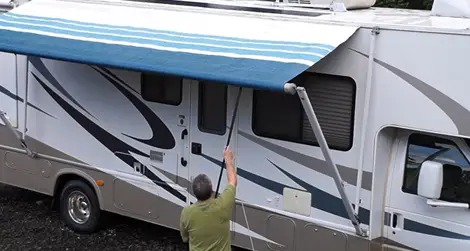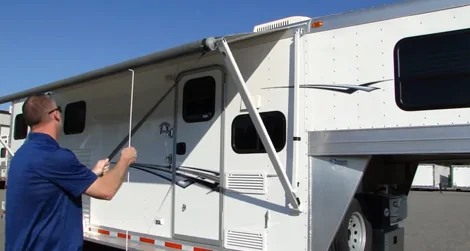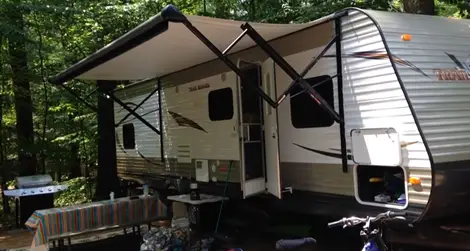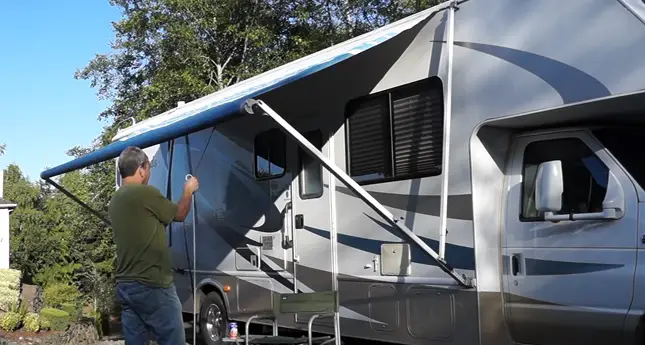Last Updated on April 20, 2023
An electric RV awning adds some extra living space to your rig. It can give you a place to relax in the shade or entertain guests with protection against rain and light winds.
The weather can be rough any time when you need to retract the awning quickly and save it from wear and tear. If you tie up your electric RV awning with knots, you may be late to take back the awning in a strong gust of wind.
A question may arise “can you tie down an electric RV awning?” According to most electric RV awning manufacturers, the electric ones should not be tied down. Here we discuss the details answers to this question so that you can make an informed decision.
Can You Tie Down an Electric RV Awning: Get the Right Answer

Awnings are essential RV parts that make your RV look complete. Electric awnings are very convenient. You can operate them with the simple push of a button.
Awning manufacturers typically recommend not tying electric awnings down, but you can use awning accessories such as a ratchet strap or an anchoring kit to secure them. It is best to tie down the manual awning in order to keep it rigid.
But why not tie down the electric awning? The main reason is that electrical awnings are designed to be retracted quickly. There are two additional reasons:
1. Put Stress on the Motor:
Tying down electric RV awnings can put unnecessary stress on the motor and components. If the strong wind catches the camper awning and starts to pull it out, the motor has to work harder to keep it in place. This can cause the motor to overheat and eventually break down.
2. Possibility of Damaging Awning Fabric:
The RV awning fabric can be damaged if it’s stretched too tight. The fabric is designed to be able to flip in the wind, so tying it down defeats its purpose. If you must tie down your awning, use only a light-weight bungee cord or rope, and be sure to leave some slack so that the awning can still move.
When to Close Your Electric Awning?

Many people enjoy spending time outdoors, but sometimes the weather can be too hot or too cold to stay outside for very long. One solution is to install an electric awning.
These awnings can be opened and closed by a button touch, providing instant shade or protection from the elements. But when should you close your electric awning? Here are a few things to consider:
Heavy Rains:
Electric awnings are a great addition to any motorhome, keeping you cool and protected. However, heavy rains can represent a serious threat to an electric awning. If left open in severe weather, an electric awning can be damaged by high wind or even by flying debris.
As a result, you need to know when to shut down your electric awning in order to protect it from the worst of the weather. Generally speaking, if there is heavy rain in the forecast, it is best to close your awning and store it until the storm has passed.
Strong Winds:
One of the most important things to remember about electric awnings is that they should be closed in high winds. This may seem like common sense, but many people forget or simply don’t know this rule.
Strong winds can cause the awning to collapse, which can damage the frame and fabric. In addition, it can also be dangerous if the awning falls on someone.
For these reasons, it’s always best to err on the side of caution and retract your awning when the wind picks up. It is better to have a wind sensor to measure wind speed.
Thunderstorms are in the Forecast:
As an experienced camper knows, thunderstorms can roll in quickly and without warning. When one is on the horizon, it’s important to know what to do to ensure that you and your belongings stay safe. One of the first things you should do is close your electric awning.
To play it safe, close your awning as soon as you see or hear signs of a thunderstorm approaching. This will help to protect your property and give you peace of mind when the storm hits.
Awning Sags due to Water:
While electric awnings are built to withstand a certain amount of moisture, they are not designed to be used in heavy rain or snow. When extended, the weight of the water can cause the awning fabric to sag.
In addition, the water can collect in the channels that run along the edge of the awning, eventually leading to leaks. For these reasons, electric awnings should be closed when bad weather is forecast.
Water damage is not covered by most policies, so it is important to take steps to protect your awning from the elements. With a little care and attention, you can enjoy many years of trouble-free use from your electric awning.
Relevant Article To Read: Mold and Mildew Prevention for RV Awnings
At Night:
Another important thing to keep in mind is closing your awning at night. Most experts recommend closing your electric awning at night. If it is located in a busy area, it could be damaged by passing pedestrians or animals.
How do You Stabilize an Electric Awning?

Stabilizing an electric awning with your camper van is a simple process that can be done in just a few minutes. You just follow these easy steps:
Step 01. Extend the Awning:
The first step is to extend the awning fully and secure it in place. This will give you the most surface area to work with and make it easier to secure the awning in place. Check that the RV awning arm is locked in place.
Step 02. Secure the Awning:
Next, use rope or bungee cords to attach the awning to the support posts. If necessary, use guy lines to fasten it further.
Step 03. Plug in the Power Cord:
Finally, connect the power cord and switch on the awning. It will be able to hold itself in place and will not need to be anchored down.
Once the awning is fully extended and secured, it should comfortably withstand medium winds and rain. In most cases, stabilizing an electric awning is all that is needed to secure it.
FAQs:
Q: How do I Stop My Electric Awning from Flapping?
If your electric awning is flapping in the wind, there are a few things you can do to stop it. One option is to use an anti-flapping kit, which attaches to the awning arms and helps to stabilize them. You can also use a stabilizing kit, which goes under the awning and helps to keep it from moving around.
Q: How Much Wind Can an RV Awning Withstand?
The answer depends on the specific model. But most awnings should be closed when wind speeds up to 25 mph are expected. If you don’t have a wind speedometer, a good rule of thumb is to close the awning when the leaves on the trees start to move.
Q: How long do Motorized Awnings Last?
The longevity of your awning will depend on many factors, such as how often you use it, the quality of the materials, and the amount of sunlight or other weather exposure it gets. 8 to 10 years is the average lifespan for a motorized awning. With proper care and maintenance, your awning can last even longer.
Q: How Much Wind Can a Retractable Awning Take?
Around 20mph is about the limit for most retractable awnings. If the wind picks up any more than that, then it’s advisable to retract the awning to prevent damage. In high winds, an awning can act as a parachute, catching the wind and pulling itself away from the building.
Q: How do You Wire an Electric Awning?
While most electric awnings come pre-wired, it is possible to wire an awning yourself. Ensure that the awning is properly mounted and secured. Run the power cable from the house to the awning. Once the cable is in place, connect it to the awning using the appropriate fittings.
Q: Are Retractable Awnings Worth It?
Awnings are a great way to enjoy the outside without having to deal with the harsh sun or inclement weather. Retractable awnings are an even better option, as they can be easily extended or retracted as needed. If you’re looking for a versatile and durable solution to enjoy your outdoor space, retractable awnings are definitely worth considering.
Conclusion:
An RV awning can help you enjoy your time outdoors without being exposed to harsh conditions. Having a retractable electric RV awning makes it easy to roll it up quickly if it starts to rain or windy.
It is possible for your electric awning to break if you tether it. The article outlined the drawbacks of tying down an electric RV awning. You’ll come up against many problems as a result of it.
Hopefully, you figured out the answer to your question, “can you tie down an electric RV awning while camping?”. Thanks for reading.


